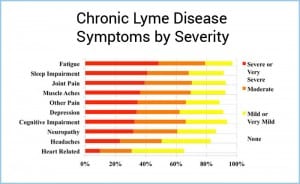Lyme Patient Quality of Life Survey Study

Severity of chronic Lyme disease compared to other chronic conditions: a quality of life survey
Below is an abstract of this study with a link to the full journal publication.
ABSTRACT
Overview. The Centers for Disease Control and Prevention (CDC) health-related quality of life (HRQoL) indicators are widely used in the general population to determine the burden of disease, identify health needs, and direct public health policy. These indicators also allow the burden of illness to be compared across different diseases. Although Lyme disease has recently been acknowledged as a major health threat in the USA with more than 300,000 new cases per year, no comprehensive assessment of the health burden of this tickborne disease is available. This study assesses the HRQoL of patients with chronic Lyme disease (CLD) and compares the severity of CLD to other chronic conditions.
Methods. Of 5,357 subjects who responded to an online survey, 3,090 were selected for the study. Respondents were characterized as having CLD if they were clinically diagnosed with Lyme disease and had persisting symptoms lasting more than 6 months following antibiotic treatment. HRQoL of CLD patients was assessed using the CDC 9-item metric. The HRQoL analysis for CLD was compared to published analyses for the general population and other chronic illnesses using standard statistical methods.
Results. Compared to the general population and patients with other chronic diseases reviewed here, patients with CLD reported significantly lower health quality status, more bad mental and physical health days, a significant symptom disease burden, and greater activity limitations. They also reported impairment in their ability to work, increased utilization of healthcare services, and greater out of pocket medical costs.
Conclusions. CLD patients have significantly impaired HRQoL and greater healthcare utilization compared to the general population and patients with other chronic diseases. The heavy burden of illness associated with CLD highlights the need for earlier diagnosis and innovative treatment approaches that may reduce the burden of illness and concomitant costs posed by this illness.


















